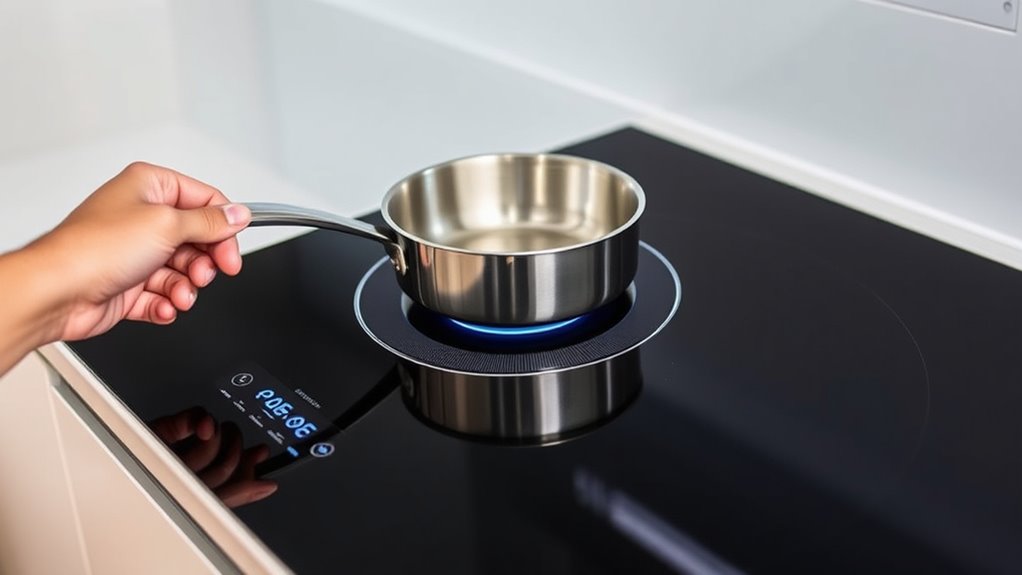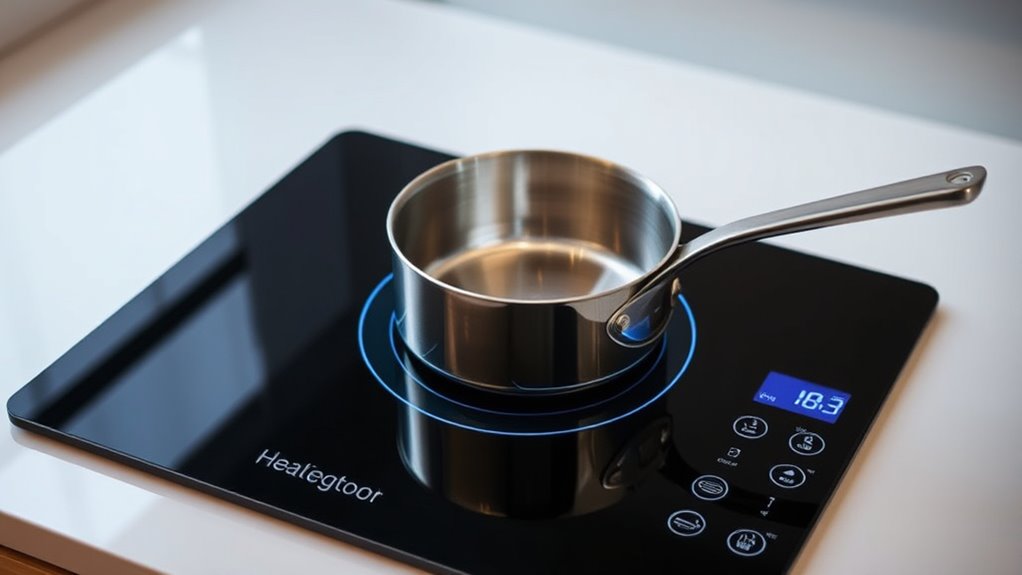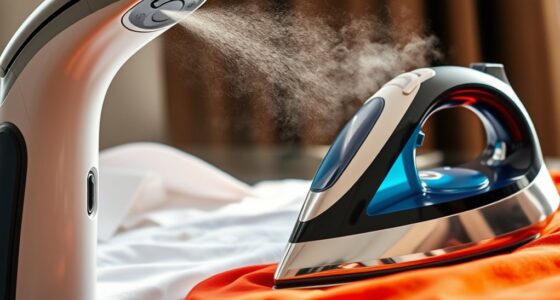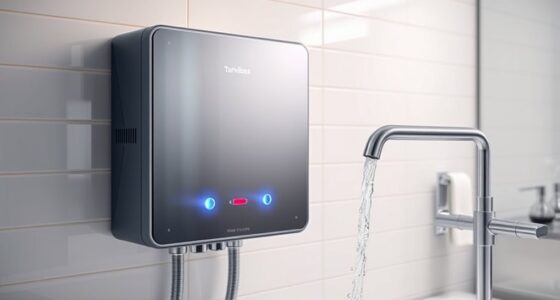Induction cooktops heat cookware directly using electromagnetic fields, so you need ferromagnetic pans like cast iron or stainless steel for them to work. You can control power levels easily for precise cooking, from simmering to boiling, while safety features like cool surfaces and auto-shutoff make cooking safer. Since heat is generated inside the pan itself, the surface stays cooler and responds quickly. If you keep exploring, you’ll discover how to choose the best cookware and maximize efficiency.
Key Takeaways
- Use ferromagnetic cookware like cast iron or stainless steel, confirmed by a magnet test, for induction compatibility.
- Power settings control heating levels precisely, enabling quick adjustments from simmer to boil.
- The cooktop surface remains relatively cool, with safety features like auto-shutoff reducing burn risks.
- Rapid heat transfer and energy efficiency make induction cooking faster and more responsive than traditional methods.
- Proper cookware, power control, and safety features ensure safe, efficient, and effective induction cooking.

Have you ever wondered how induction cooktops heat your food so quickly and efficiently? Unlike traditional stoves that rely on open flames or heated coils, induction cooktops generate heat directly within the cookware through electromagnetic fields. When you turn on the cooktop and select a setting, an electric current flows through a coil beneath the ceramic surface, creating a magnetic field. If your pan is made of ferromagnetic material like cast iron or stainless steel, this magnetic field induces electric currents—called eddy currents—inside the pan. These currents generate heat directly in the cookware, which then transfers to your food. This process allows for rapid heating, precise temperature control, and energy efficiency since less heat is lost to the surroundings. Additionally, the presence of a compatible pan is essential for the cooktop to operate safely and effectively. Choosing the right pans is vital for induction cooking. Not all cookware works with induction cooktops. You need pots and pans made of ferromagnetic materials, which can be identified by a simple test: if a magnet sticks to the bottom of your cookware, it’s compatible. If it doesn’t, the pan won’t heat up on an induction surface. Many modern cookware sets are labeled as induction-compatible, making it easier to select suitable options. The material of your cookware impacts heat distribution and cooking performance; for example, cast iron heats evenly and retains heat well, while stainless steel offers durability and good responsiveness. Avoid non-magnetic materials like aluminum, copper, or glass unless they have a magnetic layer added to the bottom. Proper cookware not only guarantees efficient heating but also prevents damage to your cooktop and prolongs the lifespan of your equipment.
Power levels on an induction cooktop are designed to give you precise control over cooking. Most models feature multiple settings, from low simmer to high boil, letting you adjust heat instantly. This responsiveness is one of induction’s biggest advantages, making it easier to prevent overcooking or burning. When you increase the power, the electromagnetic field intensifies, generating more heat in your pan. Conversely, lowering the setting reduces the magnetic activity, cooling the pan quickly. This control allows you to fine-tune your cooking process and respond quickly to changes, unlike traditional stoves that take longer to adjust temperature. The high efficiency of induction cooktops also results from direct heat transfer, minimizing energy loss during cooking.
Safety is a key benefit of induction cooking. The surface remains relatively cool because heat is generated within the pan itself, reducing the risk of burns and accidental fires. When you lift the pan off the cooktop, the electromagnetic field stops immediately, and the surface cools down quickly. Many models also come with safety features like auto-shutoff, child locks, and residual heat indicators, giving you added peace of mind. Since the surface doesn’t get hot unless a compatible pan is present, you’re less likely to sustain burns from touching the cooktop. Overall, induction cooktops offer a safer, more efficient, and precise way to cook, provided you use the right pans and understand how to manage power settings effectively.
Frequently Asked Questions
Can Induction Cooktops Be Used Outdoors?
Yes, you can use induction cooktops outdoors, but you should take some precautions. Make sure the surface is stable and protected from weather elements like rain or strong wind. Use a suitable power source, such as an outdoor-rated extension cord, and ensure proper ventilation. Keep the cooktop away from water and moisture to prevent damage or safety hazards. With these steps, you can safely enjoy cooking outdoors.
What Are the Environmental Impacts of Induction Cooking?
Think of induction cooking as a clean, green leaf in your kitchen. It’s energy-efficient, reducing waste and emissions compared to gas stoves, which emit pollutants. You help lower your carbon footprint by choosing induction, as it uses less power and produces less heat loss. Plus, it doesn’t release harmful gases, making it safer for the environment and your home. You’re actively contributing to a healthier planet with every meal you prepare.
How Do I Troubleshoot if My Induction Cooktop Isn’t Heating?
First, check if your pan is compatible; induction requires ferrous metal. Confirm it’s centered correctly on the cooktop. Verify the power source; unplug and reconnect if needed. Look for error codes or blinking lights—consult your user manual for meanings. Reset the cooktop by turning it off and on again. If it still doesn’t heat, inspect the cord and connections, or contact a professional for repairs.
Are There Specific Electrical Requirements for Installing an Induction Cooktop?
Yes, you need specific electrical requirements for installing an induction cooktop. You should verify your home’s electrical system can handle the cooktop’s power needs, often requiring a dedicated 240-volt circuit. Check the manufacturer’s specifications for amperage and wiring. It’s best to hire a licensed electrician to install it properly, guaranteeing safety and compliance with local electrical codes. Proper installation prevents damage and guarantees peak performance.
Can Induction Cooktops Be Used With Non-Stick Pans?
Yes, you can use non-stick pans on induction cooktops as long as they have a magnetic base. To check, see if a magnet sticks to the bottom of your pan. If it does, it’s compatible. Keep in mind, non-stick coatings can sometimes be sensitive to high heat, so use moderate heat settings to prevent damage. Always choose pans with flat, smooth bottoms for the best performance.
Conclusion
So, after all this, you might think induction cooktops are foolproof. Just remember, all that power and safety features still require you to stay alert—ironic, isn’t it? The very technology designed to make cooking safer can turn into a hazard if you ignore simple precautions. So, enjoy the modern marvel, but don’t let complacency turn your sleek, efficient cooktop into a kitchen mishap. Stay vigilant and cook smart—your safety depends on it.









